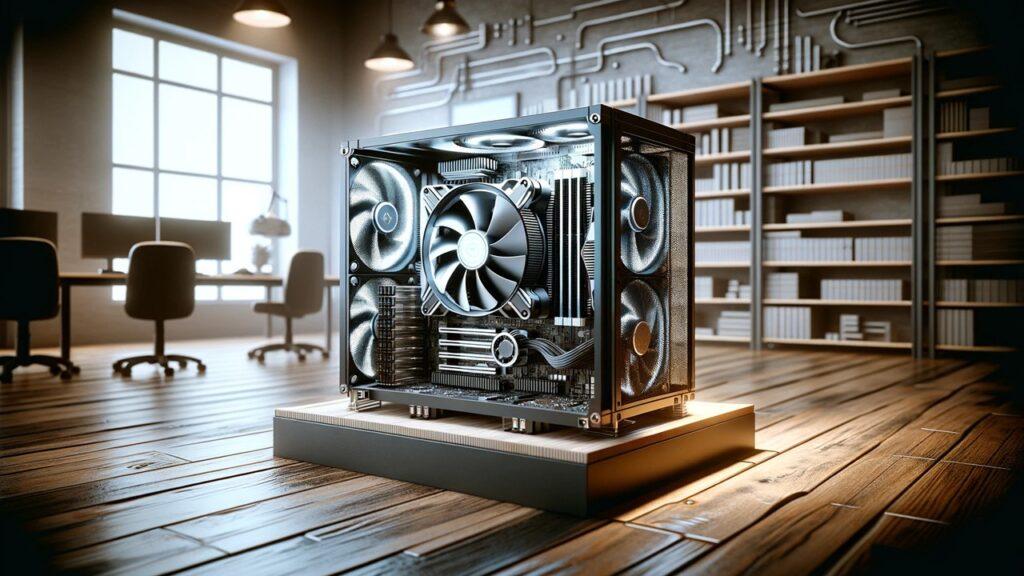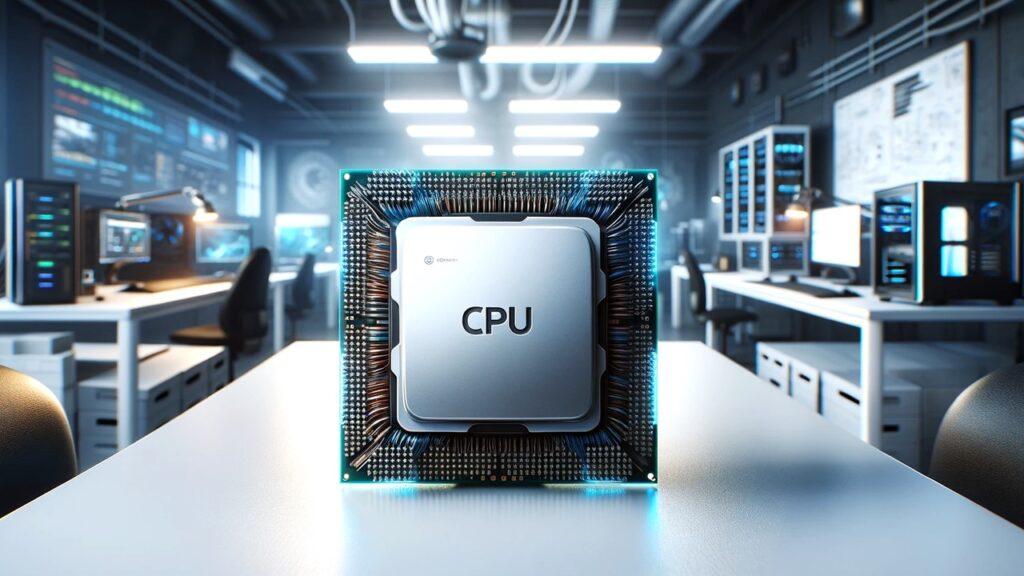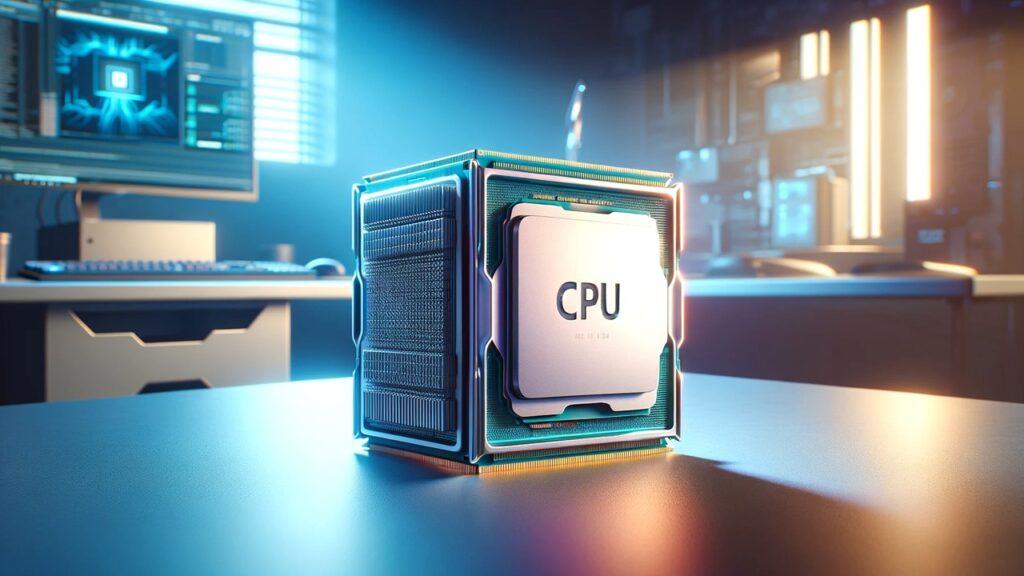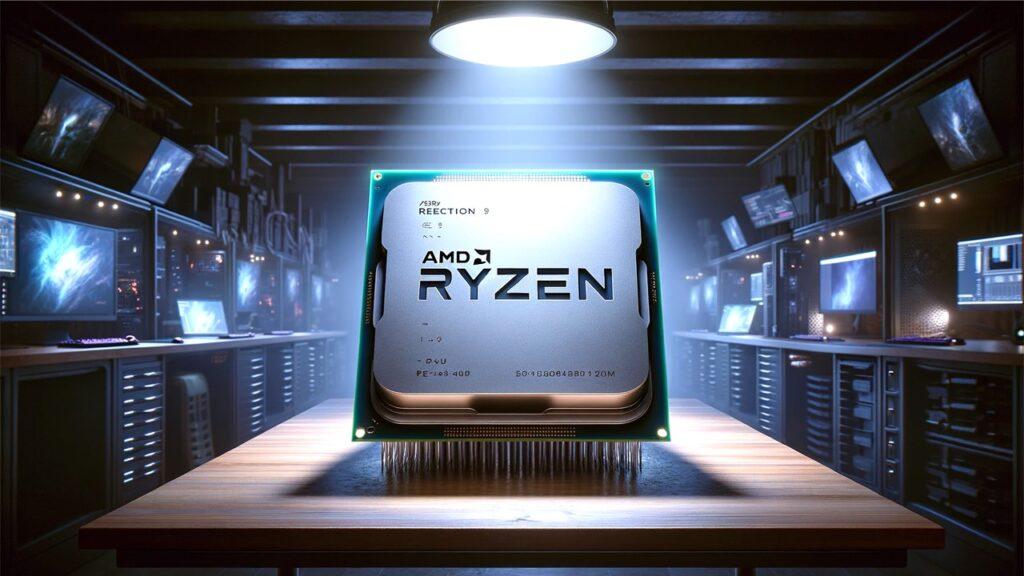We are here to help you to pick the best Intel Core CPUs for your desktop PC. Navigating the landscape of desktop PC building in 2024, the choice of CPU remains paramount. The heart of your setup, the processor, significantly influences overall system performance, efficiency, and capability to handle tasks. Within this domain, Intel Core CPUs continue to stand out, offering a range of solutions designed to meet diverse needs and preferences. In this guide, we have extensively researched, reviewed, and ranked the 5 best Intel Core CPUs for desktop PC builds in 2024. This ensures you can choose the right Intel Core CPU for your desktop PC builds from the many choices.
We’re reader-supported. When you buy through links on our site, we may earn an affiliate commission. As an Amazon Associate, we earn from qualifying purchases.
Our Top Picks Of The 5 Best Intel Core CPUs for Desktop PC Builds In 2024
1. Overall Option: Intel Core i9-13900K
2. High-Performance Gaming: Intel Core i7-13700K
3. Mid-Range Option: Intel Core i5-13600K
4. Budget-Friendly Option: Intel Core i3-14100F
5. For Creative Work: Intel Core i9-13900KF
What Is The Best Intel Core CPU for Desktop PC Builds In 2024?
In the rapidly evolving landscape of desktop PC building, choosing the perfect Intel Core CPU has never been more crucial. With 2024 ushering in groundbreaking innovations and performance enhancements, identifying the top processor for your setup is essential. This segment dives into the finest Intel Core CPUs available, tailored for those seeking unparalleled performance in their desktop PC builds. Furthermore, we will explore the attributes that set these CPUs apart, ensuring you make a well-informed decision tailored to your computing needs.
1. Overall Option: Intel Core i9-13900K

Quick Specifications
- CPU Model: Core i9-13900K
- Cores/Threads: 24 (8 P-cores + 16 E-cores), 32 threads
- CPU Speed: Up to 5.8 GHz
- CPU Socket: LGA 1700
- Cache: 36MB
In our exploration of the latest Intel offerings for desktop PC builds, the Intel Core i9-13900K stands out for its impressive blend of power and efficiency. Furthermore, with its up to 5.8 GHz speed and a total of 24 cores, this CPU is tailor-made for enthusiasts who demand top-tier performance for gaming, streaming, and content creation. The integration of Intel UHD Graphics 770 ensures that even without a discrete graphics card, preliminary graphic tasks are handled smoothly.
Moreover, compatibility with both Intel 600 and 700 series motherboards, after a simple BIOS update if necessary, offers flexibility for various PC builds. This processor not only supports the latest DDR5 memory but also maintains compatibility with DDR4, providing versatility in choosing or upgrading your system’s RAM. Furthermore, the unlocked nature of the i9-13900K invites overclocking enthusiasts to push the limits of their PC’s performance, truly making it a formidable choice for any high-end setup.
Pros
- Exceptional performance with up to 5.8 GHz speed and 24 cores.
- Integrated graphics capable of handling basic graphical tasks.
- Broad compatibility with 600 and 700 series motherboards.
- Supports both DDR5 and DDR4, allowing for flexible memory options.
Cons
- The 125W base power requirement may necessitate a robust cooling solution.
- Premium performance comes at a premium price range.
From our perspective our thorough examination reveals the Intel Core i9-13900K as a compelling selection for those aiming to assemble a cutting-edge desktop PC in 2024. In our opinion, its blend of high core count, advanced technologies like Intel Thermal Velocity Boost, and the flexibility in motherboard and memory compatibility solidifies its position. Thus, for those seeking a processor that marries extreme performance with future-proofing features, the i9-13900K emerges as the right choice on our list. Its drawbacks are easily overshadowed by its sheer capability and adaptability to both current and emerging computing demands.
2. High-Performance Gaming: Intel Core i7-13700K
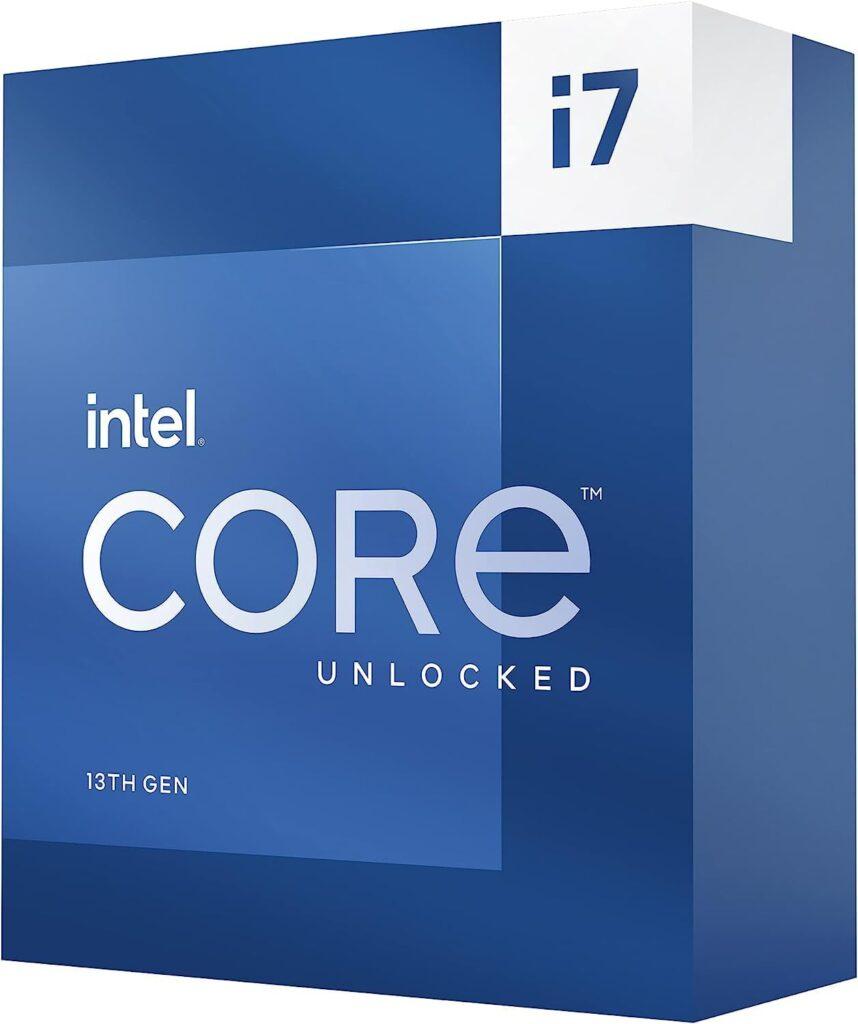
Quick Specifications
- CPU Model: Core i7-13700K
- Cores/Threads: 16 (8 P-cores + 8 E-cores), 24 threads
- CPU Speed: Up to 5.4 GHz
- CPU Socket: LGA 1700
- Cache: 30MB
In our quest to find the prime choice for high-performance gaming, the Intel Core i7-13700K has emerged as a frontrunner. This CPU’s blend of speed and multitasking capability offers a gaming experience that’s both immersive and fluid. Its 16 cores and 5.4 GHz peak speed push the boundaries of what gamers can expect from their desktop setups. Additionally, the inclusion of Intel UHD Graphics 770 and compatibility with both DDR4 and DDR5 memory make this processor a versatile foundation for any high-end gaming rig.
Moreover, the i7-13700K’s performance hybrid architecture optimally balances workloads, ensuring that gaming, streaming, and content creation proceed without a hitch. This CPU is not just about raw power; it’s about smart power. The ability to work seamlessly with a wide range of motherboards, thanks to its compatibility with both 600 and 700 series, further underscores its flexibility. Furthermore, the processor is unlocked, inviting gamers and enthusiasts to fine-tune their systems for even greater performance.
Pros
- High core count and speed cater to demanding gaming and multitasking.
- Integrated graphics enable basic tasks without a discrete GPU.
- Flexibility in motherboard and memory compatibility broadens build options.
- Unlocked for customization, offering an avenue for tailored overclocking.
Cons
- The processor’s high performance comes with a higher power requirement.
- A dedicated cooling solution is needed to manage the CPU’s thermal output.
From our standpoint, after careful review, we’ve found the Intel Core i7-13700K to be an excellent choice for gamers seeking a processor that combines exceptional performance with future-proofing features. Its adept handling of intensive gaming scenarios, along with the capability to drive content creation and everyday tasks, positions it as a versatile cornerstone for any gaming-oriented PC builds. In our opinion, the minor considerations regarding power and cooling are typical for a CPU of this caliber and do not detract from its considerable appeal. Thus, it stands as a proper choice for those looking to elevate their gaming experience on our list.
3. Mid-Range Option: Intel Core i5-13600K
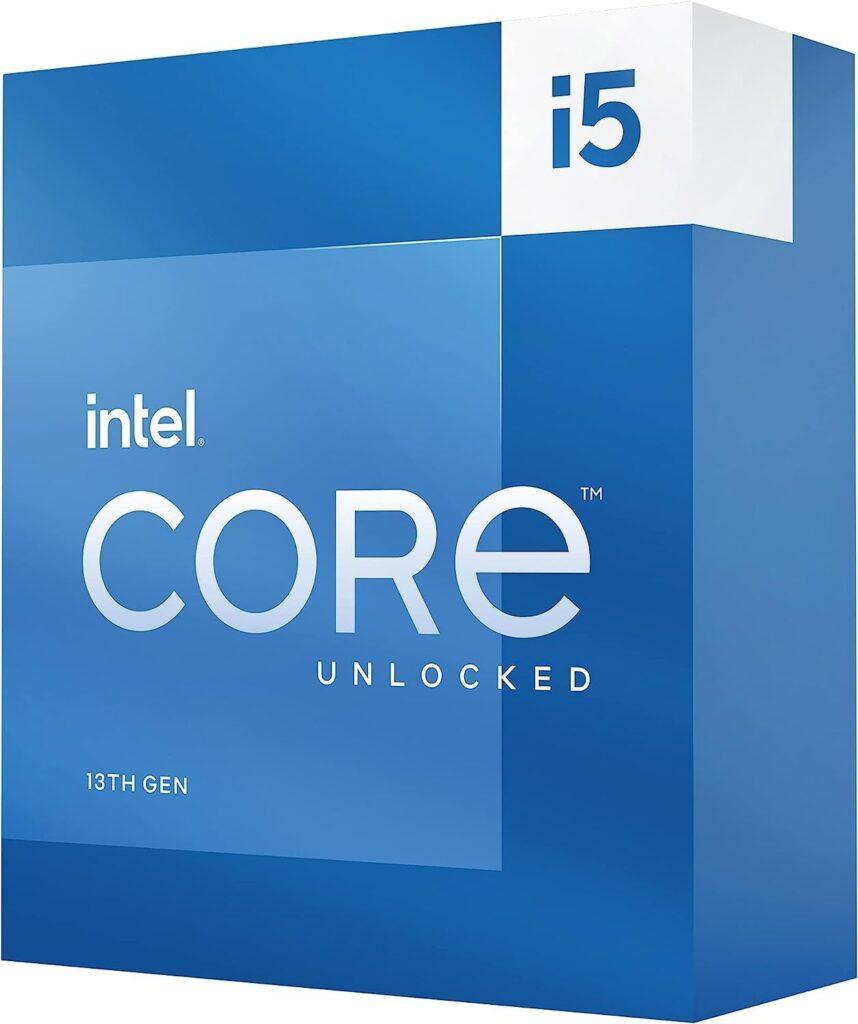
Quick Specifications
- CPU Model: Core i5-13600K
- Cores/Threads: 14 (6 P-cores + 8 E-cores), 20 threads
- CPU Speed: Up to 5.1 GHz
- CPU Socket: LGA 1700
- Cache: 24MB
In our journey to find mid-range CPUs, the Intel Core i5-13600K strikes an impressive balance between performance and price, making it a standout choice for mid-range PC builds in 2024. Its 14 cores and up to 5.1 GHz speed cater admirably to both gaming and productivity tasks, ensuring a seamless experience. Furthermore, the inclusion of integrated Intel UHD Graphics 770 allows for decent graphical output without the immediate need for a discrete GPU, offering versatility for various user needs.
Moreover, the i5-13600K’s compatibility with both the latest DDR5 and the more accessible DDR4 memory types, alongside support for PCIe 5.0 & 4.0, showcases its adaptability to different system configurations. This processor not only promises a powerful computing experience but also ensures future-proofing, thanks to its support for next-generation technologies. Nevertheless, the absence of Intel Turbo Boost Max 3.0 may limit peak performance compared to higher-tier counterparts, yet this CPU still holds its ground well.
Pros
- Excellent performance-to-price ratio suits a wide range of PC builds.
- Integrated graphics offer flexibility for early system use without a GPU.
- Broad motherboard compatibility enhances build versatility.
- Unlocked for overclocking, appealing to enthusiasts seeking custom performance tuning.
Cons
- Higher power requirement necessitates a solid cooling solution.
- Lacks Intel Turbo Boost Max 3.0, which could enhance single-threaded tasks.
From our perspective, our examination positions the Intel Core i5-13600K as an excellent choice for those aiming to construct a mid-range PC that doesn’t compromise on performance. Its capabilities align well with both gaming and professional workloads, marking it as a versatile and cost-effective processor. Therefore, from our standpoint, for users looking to balance cost with cutting-edge performance, the Core i5-13600K emerges as a proper choice on our list, combining the latest in processing technology with practical adaptability.
4. Budget-Friendly Option: Intel Core i3-14100F
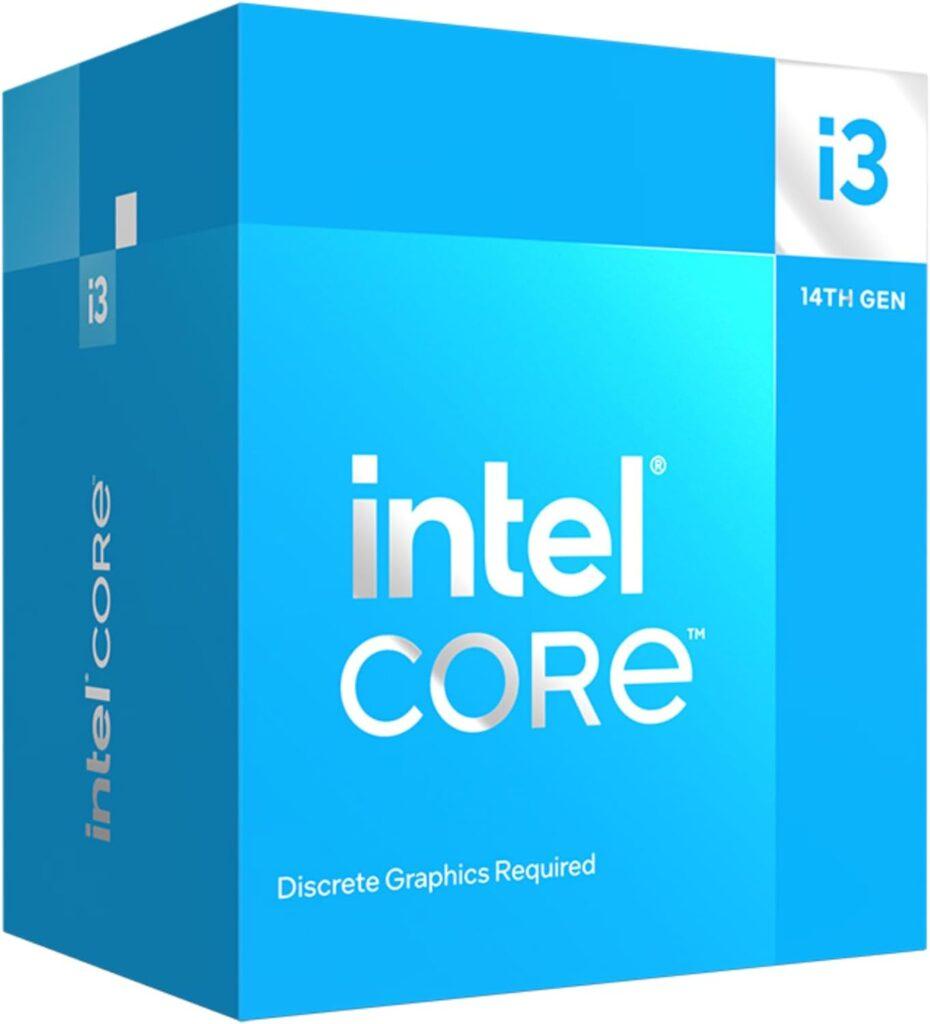
Quick Specifications
- CPU Model: Core i3-14100F
- Cores/Threads: 4 (4 P-cores + 0 E-cores), 8 threads
- CPU Speed: Up to 4.7 GHz
- CPU Socket: PGA LGA1700
- Cache: 12MB
From our viewpoint, the Intel Core i3-14100F represents a striking balance between affordability and reliable performance for those assembling budget-conscious PC builds in 2024. Its four cores and 4.7 GHz peak speed deliver ample power for everyday computing tasks, productivity applications, and entry-level gaming. The processor’s compatibility with both DDR4 and DDR5 memory, as well as PCIe 5.0 & 4.0, means users won’t have to compromise on future-proofing their systems, even with a tighter budget.
Additionally, the i3-14100F’s lower power consumption of just 58W and the inclusion of the Intel Laminar RM1 cooling solution make it an efficient and cool-running choice for compact and quiet PCs. While the lack of integrated graphics necessitates a discrete GPU, this could be a silver lining for those looking to customize their build with dedicated graphics power. Furthermore, its compatibility with a wide range of motherboards offers flexibility in choosing the rest of the build components.
Pros
- Offers solid performance at an attractive price point.
- Low power consumption enhances energy efficiency.
- Supports the latest DDR4 and DDR5 memory for flexible upgrade paths.
- Comes with a cooling solution, easing the initial setup process.
Cons
- Requires a discrete graphics card, adding to the total build cost.
- Limited to four cores, which might not suit more demanding applications.
In our opinion, our assessment underscores the Intel Core i3-14100F as a proper choice for budget-friendly PC builds. It provides a foundation that meets the needs of general computing and light gaming without straining finances. Thus, for those prioritizing cost-effectiveness while still longing for respectable performance and future readiness, the Core i3-14100F emerges as an excellent choice on our list. Its limitations are modest in light of its benefits, making it a smart pick for value-driven builders from our perspective.
5. For Creative Work: Intel Core i9-13900KF

Quick Specifications
- CPU Model: Core i9-13900KF
- Cores/Threads: 24 (8 P-cores + 16 E-cores), 32 threads
- CPU Speed: Up to 5.8 GHz
- CPU Socket: LGA 1700
- Cache: 36MB
In our journey through the latest and greatest in the Intel Core lineup, the i9-13900KF has captured our attention for its sheer power and flexibility. Tailor-made for creative professionals and enthusiast gamers, this CPU stands out with its impressive core count and top-tier clock speeds. Its hybrid architecture ensures that whether you’re rendering video, compiling code, or diving into immersive gaming worlds, performance remains swift and seamless.
Furthermore, the i9-13900KF’s support for both DDR4 and DDR5 memory, alongside PCIe 5.0, offers a level of future-proofing that’s hard to overlook. Its unlocked nature invites overclocking, providing an opportunity for users to push the CPU’s performance to new heights, tailored to their specific needs. However, the requirement for discrete graphics might add an extra step for some, and the absence of an included thermal solution means additional consideration for cooling is necessary.
Pros
- Higher core and thread count for intensive multitasking and creative work.
- High clock speeds ensure peak performance for demanding applications.
- Support for latest memory and PCIe standards.
- Overclockable for customized performance enhancements.
Cons
- Requires a separate purchase of a discrete graphics card.
- No included thermal solution, necessitating an additional investment in cooling.
From our standpoint, our analysis reveals the Intel Core i9-13900KF as an exceptional choice for those looking to build a top-tier PC. In our opinion, Its robust performance capabilities make it ideally suited for users who demand the very best, whether for gaming, content creation, or other demanding applications. While there are considerations to be made regarding additional components, the i9-13900KF stands as a proper powerhouse in our list, offering the kind of forward-thinking technology and raw power that creative professionals and tech enthusiasts dream of.
Understanding Intel Core CPUs
Diving deep into the tech landscape of this year, choosing the perfect heart for your desktop PC isn’t just about ticking boxes; it’s about understanding what beats at the core of Intel’s powerhouse lineup. With Intel’s Core CPUs, it’s like picking the brain that’s going to power all your digital dreams, from epic gaming sessions to crunching big data or just binge-watching your favorite shows in unparalleled quality.
History and Evolution of Intel Core CPUs
Let’s take a quick trip down memory lane. Intel’s Core CPUs have been with us for quite a spin, evolving from humble beginnings to become the powerhouse brains behind some of the most powerful PCs on the planet. Each leap from one generation to the next brought with it more speed, more efficiency, and the ability to do more at once without breaking a sweat. It’s been a journey marked by Intel’s push to constantly up the game, ensuring that with every new chip, your PC feels like it’s getting a turbo boost.
Different Series of Intel Core CPUs Explained
Wading through Intel’s Core series is like exploring a menu at a gourmet restaurant; each has its unique flavor, suited to different palates. Starting with the Core i3, it’s your go-to for getting quality performance without draining your wallet – perfect for everyday tasks and light gaming. Step up to the Core i5, and you’re hitting the sweet spot of price and performance, with enough oomph for serious gaming and productivity.
The Core i7 ramps things up further for those power-hungry applications and multitasking galore. And then there’s the Core i9 – the crème de la crème, designed for those who refuse to compromise, offering peak performance for gaming, content creation, and more.
Latest Technologies in Intel Core CPUs
Intel’s not just about adding more cores or cranking up the GHz anymore. The latest chips come packed with tech that sounds like it’s straight out of a sci-fi novel. Think blazing-fast speeds with Intel Thermal Velocity Boost, smart multitasking with Intel Hyper-Threading, and next-gen readiness with PCIe 5.0 support. Plus, with support for both DDR4 and DDR5 memory, these CPUs are not just about being faster; they’re about being smarter and more efficient.
Intel’s Core CPUs are setting the stage for this year where your PC can be anything you need it to be – a gaming beast, a creative powerhouse, or a multitasking master. With each new iteration, Moreover, Intel continues to push the envelope, ensuring that whatever your digital dreams, there’s a Core CPU ready to bring them to life. And as the rumors swirl and the tech world buzzes with anticipation, one thing’s for sure: the next big thing is just around the corner, and it’s going to be exciting.
Do You Need Intel Core CPUs for Desktop PC Builds?
Embarking on a desktop PC build journey this year invites a crucial question: Is an Intel Core CPU the heart your setup needs? The answer isn’t straightforward, as it dances around your specific demands, expectations, and the constantly evolving tech landscape. This section delves deep into understanding those needs and pits Intel’s Core lineup against the fierce competition, setting the stage for an informed decision.
Analyzing Your PC Building Needs
First off, let’s decode the blueprint of your dream PC. Are you aiming to conquer the latest triple-A titles, churn through 4K video edits, or simply need a reliable rig for everyday tasks and light gaming? Your answer shapes the cornerstone of your build. Intel Core CPUs, with their diverse range from i3 to i9, offer solutions across the spectrum. Moreover, considering future needs is just as vital; opting for a slightly higher spec than your current needs could extend the lifespan of your PC significantly.
Intel Core CPUs vs Other Brands
The battle of the brands is hotter than ever in recent years. While Intel Core CPUs have been a dominant force, AMD and others have not been sitting quietly. The choice between Intel and its rivals boils down to a few key facets: performance, power efficiency, and price. Intel’s latest offerings boast cutting-edge technologies like PCIe 5.0 support and advanced thermal management, promising peak performance. However, competitors often undercut Intel on price, offering compelling alternatives for budget-conscious builders.
Furthermore. diving into the PC building adventure with all the facts in hand ensures your build is a reflection of your needs, aspirations, and budget. Intel Core CPUs stand out with their unmatched versatility, cutting-edge technology, and robust performance. Yet, the landscape is filled with worthy adversaries offering tantalizing alternatives. Whichever path you choose, the key is to balance your needs with your budget, ensuring your build is not just a machine, but a testament to your personal computing journey.
How To Choose The Right Intel Core CPU for Your PC Build
In the dynamic world of desktop PC building, selecting the perfect Intel Core CPU is more crucial than ever. It’s a decision that influences not just the performance of your system today but its viability years down the line. With an array of options from Intel’s lineup, understanding the nuances of CPU specifications, compatibility, and future-proofing your build becomes paramount. Let’s navigate through these key areas to ensure your PC build is not just powerful but also a forward-looking investment.
Understanding CPU Specifications
Peeling back the layers on CPU specifications reveals a complex world of cores, threads, clock speeds, and cache sizes. Cores and threads are the workhorses of multitasking, with more allowing your PC to handle numerous tasks simultaneously without a hitch. Clock speed, measured in GHz, dictates how fast a CPU processes instructions, impacting everything from gaming to application performance. Additionally, cache size is the CPU’s onboard memory, where higher amounts can significantly speed up data access. Grasping these concepts is the first step in matching your PC build to your performance expectations.
Matching CPU with Other PC Components
A harmonious PC build is about more than just a powerful CPU. It’s about how that CPU works in concert with your motherboard, RAM, graphics card, and storage. Compatibility with your motherboard’s socket is non-negotiable, while the choice between DDR4 and DDR5 RAM will be influenced by your CPU’s capabilities. Similarly, balancing your CPU’s power with your GPU ensures neither component becomes a bottleneck, allowing you to maximize the potential of both. This careful orchestration of components ensures a seamless and efficient PC builds.
Future-Proofing Your PC Builds
In the fast-paced tech world, future-proofing your PC builds is a wise strategy. Opting for a CPU with the latest socket compatibility, PCIe lanes for future expansion cards, and support for the newest memory standards extends the relevance of your build. Additionally, considering CPUs with unlocked multipliers allows for future overclocking, squeezing out more performance as your needs grow. This forward-looking approach ensures your investment remains robust and adaptable to emerging technologies and software demands.
The journey to choosing the right Intel Core CPU for your 2024 PC build intertwines technical knowledge with strategic foresight. Understanding CPU specs sets a solid foundation, ensuring compatibility with other components harmonizes your build, and future-proofing your selection safeguards your investment against rapid technological advances. By meticulously considering each of these aspects, you position your PC not just as a powerful tool for today but a capable companion for the years ahead.
Planning Your Intel Core CPU-Based PC Builds
As we step into 2024, the art of assembling a desktop PC around an Intel Core CPU has evolved, with each component playing a pivotal role in crafting a system that’s both powerful and efficient. Whether you’re a gamer, a creative professional, or someone who craves top-tier computing power, understanding the symbiosis between the CPU and other critical components is key. This guide delves into the essentials of putting together an Intel Core CPU-based build, focusing on the components that matter the most.
Essential Components for Intel Core CPU PC Setups
Central to any PC builds is the motherboard, a component that needs to match the Intel Core CPU’s socket type for a seamless fit. Furthermore, RAM compatibility and expansion slots are crucial for future upgrades. Selecting the right storage, both SSDs for speed and HDDs for capacity, tailored to the Intel Core’s capabilities, ensures a swift and responsive system. Lastly, a graphics card that complements the CPU’s performance can elevate your gaming or content creation setup to new heights.
Cooling Solutions for Intel Core CPUs
Keeping your Intel Core CPU cool not only maintains performance but also extends its lifespan. Furthermore, air cooling solutions, favored for their reliability and cost-effectiveness, are a good start. However, for those pushing their CPUs with overclocking or intensive tasks, liquid cooling systems offer superior temperature management. The choice hinges on your build’s performance demands and budget constraints, yet either option should align with the CPU’s thermal design power (TDP) specifications.
Power Supply Requirements
The heart of your PC build’s electrical system, the power supply unit (PSU), must be chosen with care. A PSU with enough wattage to support the Intel Core CPU, along with all other components, is fundamental. Opting for a unit with a higher efficiency rating not only ensures stable power delivery but also contributes to lower energy bills. Remember, a little extra headroom in wattage can be a boon for future expansions or upgrades.
Case Selection for Optimal Airflow and Aesthetics
The final piece of the puzzle, the PC case, does more than just house all the components; it affects airflow, cooling, and even the overall aesthetics of your setup. Cases designed with adequate ventilation, dust filters, and room for fans or liquid cooling radiators are paramount for maintaining optimal operating temperatures. Moreover, the size and design of the case should reflect your personal style while accommodating all your components comfortably.
Planning an Intel Core CPU-based PC build demands a holistic approach, where each component is selected not just on its merit but how it complements the heart of your system—the CPU. From ensuring compatibility across the motherboard, RAM, and GPU to choosing the right cooling solutions, power supply, and case, every decision contributes to a build that’s both high-performing and aesthetically pleasing. With careful planning and a bit of foresight, you can assemble a PC that not only meets today’s demands but is also ready for tomorrow’s challenges.
Installing and Configuring Your Intel Core CPU
The year heralds a new era for PC enthusiasts and builders, with the latest Intel Core CPUs at the forefront of technology, promising unmatched performance for your desktop build. Yet, harnessing this power is not just about securing the best processor. Proper installation and configuration are crucial steps that ensure your CPU not only functions but thrives within your setup. Furthermore, this guide breaks down the process into manageable steps, from physically installing your Intel Core CPU to optimizing its settings via BIOS for peak performance.
Step-by-Step CPU Installation Guide
Installing an Intel Core CPU is a journey that begins with preparation and ends with the satisfaction of a job well done. First, ensure your workspace is clean and static-free. Gently place your motherboard onto a flat surface and locate the CPU socket. Open the socket cover carefully. Align your Intel Core CPU with the socket, paying close attention to the notches and the triangle indicator, ensuring a perfect fit without force. Once seated, secure the CPU by closing the socket cover, which will require a bit of pressure. This crucial step, done correctly, sets the foundation for your PC’s performance.
BIOS Setup and Configuration
With the CPU securely installed, next comes the BIOS configuration, a pivotal step in unleashing the full potential of your Intel Core CPU. Power on your system and enter the BIOS by pressing the designated key during boot-up, often “Del” or “F2.” Here, you’ll encounter a myriad of settings. Focus on CPU-specific options like adjusting the clock speed and voltages if you’re into overclocking, but proceed with caution to avoid damage. Ensure that your RAM is running at the correct speed by enabling XMP profiles, and don’t forget to update the BIOS to the latest version for optimal compatibility and performance.
The path to leveraging the power of an Intel Core CPU desktop build is two-fold: meticulous physical installation and careful BIOS configuration. Each step, executed with attention to detail, guarantees that your system is not just operational but optimized for the tasks at hand, whether it be gaming, content creation, or day-to-day tasks. This journey, though intricate, is rewarding, laying the groundwork for a PC that meets the demands of tomorrow’s computing landscape.
Troubleshooting Common Intel Core CPU Issues
Navigating the intricacies of maintaining an Intel Core CPU can seem daunting, especially as we move into this year. with increasingly sophisticated technology. Despite their renown for reliability and power, even the best Intel Core CPUs are not immune to issues such as overheating or suboptimal performance. Recognizing and addressing these challenges early can drastically enhance your computing experience, ensuring your desktop PC remains a powerhouse for both work and play. Let’s dive into common issues and their solutions, ensuring your Intel Core CPU runs smoothly.
Overheating and How to Address It
Overheating is a prevalent concern, yet it’s often manageable with the right approach. First and foremost, verify the proper installation of your CPU cooler; an incorrect mount can lead to inadequate cooling. Reapplying thermal paste with a pea-sized amount at the center of the CPU can improve heat transfer. Enhancing case airflow is equally vital—reorganize cables and ensure your intake and exhaust fans are correctly positioned to promote air circulation. Regularly cleaning dust from your system also prevents heat buildup. If these steps don’t cut it, upgrading your cooling system might be the next best course of action.
Performance Optimization Tips
Maximizing your Intel Core CPU’s performance involves several strategic adjustments. Start by ensuring your BIOS is up to date, as manufacturers frequently release updates that improve system stability and performance. Adjusting your system’s power settings to ‘High Performance’ can also unleash the full potential of your CPU. For those comfortable with diving deeper, overclocking offers a pathway to increased performance, though this should be approached with caution and proper cooling. Additionally, pairing your CPU with high-speed memory and ensuring it’s operating at the correct frequency can lead to significant performance gains.
Furthermore, troubleshooting common issues with your Intel Core CPU ensures that your desktop PC remains a reliable and powerful tool. From addressing overheating with practical cooling solutions to tweaking settings for optimal performance, each step is crucial in maintaining and enhancing your system’s capabilities. Additionally, armed with these insights, you’re well-equipped to tackle any challenges that come your way, ensuring your Intel Core CPU-powered PC build is ready to tackle the demands of this year and beyond.
Wrapping It Up!
Our exploration into the pivotal role of Intel Core CPUs in desktop PC builds, the journey reveals a landscape where choosing the right processor stands as a cornerstone decision. The Intel Core series, from the versatile i3 to the powerhouse i9, offers a spectrum of options catering to a wide array of computing needs. Each variant brings forth its unique strengths, whether it’s for gaming, creative work, or general productivity, underscoring the importance of matching the CPU to your specific requirements.
Moreover, the installation and configuration process, while daunting to some, opens up avenues for optimizing your system’s performance and longevity. Addressing common issues such as overheating with appropriate cooling solutions, and tweaking BIOS settings, further enhances the efficiency and durability of your setup. Additionally, understanding and navigating through potential troubleshooting scenarios ensures that your PC build not only performs optimally but also stands the test of time.
Equally important, future-proofing your build, by considering upgradability and compatibility with emerging technologies, positions your Intel Core CPU-based PC to tackle not just current applications but also those yet to come. In essence, the choice of an Intel Core CPU becomes not just about the immediate boost in performance but about crafting a system that grows and evolves.
In conclusion, the selection of an Intel Core CPU forms the bedrock of a high-performing desktop PC build, blending the art of precision in choice and configuration with the science of cutting-edge technology. It’s a decision that goes beyond mere specifications, touching upon the very essence of what makes a PC build tailored, efficient, and ready for the next upgrade.
Related FAQs
What Are The Key Differences Between I3, I5, I7, And I9 Intel Core CPUs?
Intel’s i3 offers basic performance, while i9 provides high-end processing power.
How Can I Determine Which Intel Core CPU Suits My Desktop Pc’s Requirements?
Assess factors like budget, usage (e.g., gaming, productivity), and desired performance levels.
What Does “Turbo Boost” Technology Do In Intel Core CPUs?
Turbo Boost dynamically increases CPU clock speed for enhanced performance when needed.
Can I Overclock Intel Core CPUs For Better Performance?
Yes, but it’s recommended to use unlocked “K” series CPUs and proper cooling solutions.
Are Intel Core CPUs Compatible With All Motherboard Types?
No, ensure compatibility by matching CPU socket type with motherboard socket.

Ashraful Masum is an author at TheTechFluencer. He specializes in writing articles for businesses who want to improve their Google search rankings to compete with their competition. Over the past eight years, Ashraful has been working independently and through online employment platforms such as Upwork and Fiverr, and also contributing to some reputable blogs. His goal is to balance informative and affiliate content and provide real value to his readers.

